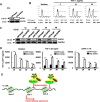Scaffold attachment factor B suppresses HIV-1 infection of CD4+ T cells by preventing binding of RNA polymerase II to HIV-1's long terminal repeat
- PMID: 29887524
- PMCID: PMC6078458
- DOI: 10.1074/jbc.RA118.002018
Scaffold attachment factor B suppresses HIV-1 infection of CD4+ T cells by preventing binding of RNA polymerase II to HIV-1's long terminal repeat
Abstract
The 5' end of the HIV, type 1 (HIV-1) long terminal repeat (LTR) promoter plays an essential role in driving viral transcription and productive infection. Multiple host and viral factors regulate LTR activity and modulate HIV-1 latency. Manipulation of the HIV-1 LTR provides a potential therapeutic strategy for combating HIV-1 persistence. In this study, we identified an RNA/DNA-binding protein, scaffold attachment factor B (SAFB1), as a host cell factor that represses HIV-1 transcription. We found that SAFB1 bound to the HIV-1 5' LTR and significantly repressed 5' LTR-driven viral transcription and HIV-1 infection of CD4+ T cells. Mechanistically, SAFB1-mediated repression of HIV-1 transcription and infection was independent of its RNA- and DNA-binding capacities. Instead, by binding to phosphorylated RNA polymerase II, SAFB1 blocked its recruitment to the HIV-1 LTR. Of note, SAFB1-mediated repression of HIV-1 transcription from proviral DNA maintained HIV-1 latency in CD4+ T cells. In summary, our findings reveal that SAFB1 binds to the HIV-1 LTR and physically interacts with phosphorylated RNA polymerase II, repressing HIV-1 transcription initiation and elongation. Our findings improve our understanding of host modulation of HIV-1 transcription and latency and provide a new host cell target for improved anti-HIV-1 therapies.
Keywords: HIV; host–pathogen interaction; viral transcription; virology; virus.
© 2018 Ma et al.
Conflict of interest statement
The authors declare that they have no conflicts of interest with the contents of this article. The content is solely the responsibility of the authors and does not necessarily represent the official views of the National Institutes of Health
Figures





References
Publication types
MeSH terms
Substances
LinkOut - more resources
Full Text Sources
Other Literature Sources
Medical
Molecular Biology Databases
Research Materials

